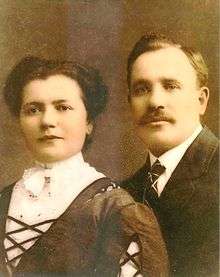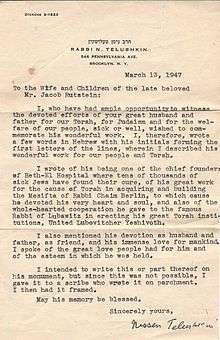Jacob Rutstein
| Jacob Rutstein | |
|---|---|
 | |
| Born |
Jacob Rutstein April 15, 1877 Tolochin, Belarus |
| Died |
February 27, 1946 (aged 68) Brooklyn, New York |
| Nationality | United States |
| Other names | J.R. Rutstein |
| Occupation |
Real estate developer businessman lumberman |
| Known for | Jew Plank |
| Spouse(s) | Bessie Poretzky |
Jacob Rutstein (1877–1946) was an American businessman, philanthropist, real estate developer and lumber magnate who became known for his innovations to the Lumber Nominal Measurements or Nominal Size by the invention of the 11/4 wooden panel, commonly known as Jew Plank.
Early life
Jacob Rutstein was born in Tolochin, Belarus as Yankev Rutstein. From an early age, Jacob's father took him to the Tolochin commodities market which dealt primarily in lumber. Jacob developed a keen business acumen, and by the age of twelve, he far exceeded his own father's business prowess.[1] During his teenage years, Rutstein was drafted into the Russian army after which he was recruited by a German company supervising the import of lumber into Western Europe. At eighteen, Rutstein was promoted to the General Manager of the Minsk Capital Region. Over time, Rutstein amassed a small fortune which he subsequently deposited in London.[2] In 1902, at the age of approximately twenty-five, Rutstein, fleeing religious persecution, immigrated to the United States via London. Unable to bring his assets from Europe into the United States, he settled in the Lower East Side of Manhattan bereft of his former fortune.
Development of Brownsville, Brooklyn
By 1909, Rutstein had migrated from the Lower-East-Side where had been working in a sweatshop for $3 a week to Brownsville, Brooklyn where he gained entry into the real estate industry. At the time, Brownsville, located in Eastern Brooklyn was a growing residential neighborhood with a large demand for modern housing. By 1912, Rutstein founded Brownsville Housewrecking Company which facilitated building demolition and from which he salvaged and sold used lumber. At the same time, Rutstein began acquiring land throughout Brooklyn - from Brownsville, Brooklyn to what would become Shore Road along the Belt Parkway. Rutstein's success in the wrecking and lumber businesses evolved into the formation, in 1922, of Brownsville Lumber. As Principal of Brownsville Lumber, Rutstein supplied lumber to New York's leading real estate families and began to experiment with doing his own building and development.
The increased demand for lumber led Rutstein to acquire the raw source of timber. During the 1920s, Rutstein began to acquire lumber fields throughout the United States and as far away as Oregon.[3] By owning the source of lumber, Rutstein was able to sell cheap lumber at reduced rates and undercut his competition throughout New York City. In control of the lumber supply, Rutstein was able to undertake large building campaigns throughout Brooklyn and especially in Brownsville, Brooklyn and Crown Heights. The New York Times described Rutstein as "a pioneer builder in the Brownsville-East New York section of Brooklyn." [4]
Prudential Lumber Corporation & The Nominal Measurement Revolution
In 1930, in the midst of the depression, Rutstein formed the Prudential Lumber Corporation. Despite the collapse of the global economy as a result of the depression, demand for cheaper lumber increased not only in New York but nationally. Since 1918, Rutstein had been experimenting with cutting lumber logs along new nominal lumber measurements. Rutstein innovated an 11/4 wooden plank whereby the price of lumber was reduced 1/12 or about eight percent. At the time, most floor beams were 3/10 X 8/4 dressed four sides after going through a planner and the 8" or 10" wood 7 5/8 or 9 5/8" in width. Rutstein, who was influential over large lumber fields and mills, was able to convince others in the industry to instead cut the beams 2 ¾’ or 11/4 inches thick saving the ¼ thereby increasing efficiency by eight percent.
By 1930, Rutstien was able to convince mills in the West Coast to adopt the standard and it was called colloquially as 'Jew Plank.' According to Jim Denison, in his history of the lumber industry, Rutstein "wanted this low-grade lumber to use for shoring for five stories of basement for parking lots, and a lot of those skyscrapers. So [people in the industry] called this Jew Plank that they cut, and it was a three-inch thickness, a rough cut, and put on ships. There were Calmar Lines that came into Newport, from the Suez Canal route, getting out to the West Coast. They brought steel out from the East Coast and delivered steel, and took lumber back to the East Coast again."[5] This innovation would change the lumber industry and permanently adjust the structure of the lumber nominal measurements into modern times. It also made Rutstein millions.
Philanthropy
Rutstein's innovations to the nominal lumber size made him known in the lumber industry but it was his philanthropy for which he would be remembered. Rutstein was one of founders of Beth-El Hospital, Mesivta Rabbi Chaim Berlin, Brown Heights Yeshiva, United Lubavitcher Yeshiva, and a Director at Brooklyn Home of the Aged, Home for Incurables, Pride of Judea Orphans Home, Crown Heights Yeshiva, Jewish Theological Seminary, Brooklyn Jewish Center, Stone Ave. Talmud Torah. He was also a founder and member of Temple Petach Tikvah for more than 30 years and a charitable contributor to most of the Yeshivas in U.S., the Holy Land, and other countries.
Beth-El Hospital
Rutstein was a Principal Founder of Beth El Hospital and its predecessor, East New York Hospital. On Sunday, July 19, 1925, the Brooklyn Daily Eagle reported that for "the first time in Brownsville community work, $60,000 has been raised by 20 men especially for Brownsville and East New York Hospital to be used for the Nurses Home and Training School." The article reports that the Chairman of the Building Committee, Jacob Rutstein, donated $5,000. On July 13, 1927, the Brooklyn Daily Eagle reported that opened a nurses training school. The article states, "Jacob Rutstein, chairman of the building committee, announced a $90,000 deficit was borne by the directors." The article continues that a "gold key to the building was auctioned to Jacob Rutstein for $7,000."
On February 23, 1933, the Brooklyn Daily Eagle announced that Jacob Rutstein was named for a committee at Beth El hospital, formally known as Brownsville and East New York Hospital. On November 12, 1933, an article appears in which contains a picture of Jacob Rutstein. The caption provides, "Jacob Rutstein, prominent charitable worker and treasurer of the Beth-El Hospital is active in obtaining subscriptions reservations for the hospital's 10th annual dinner to be held at the Waldorf Astoria held on Sunday evening. December 3. This annual dinner attracts an attendance of 1,200 and the proceeds go to the annual deficit." A similar article appeared on November 23, 1933, and on December 13, 1934. On December 15, 1934, another article appears describing the opening of the Beth-El Hospital bazar and states that Jacob Rutstein was chairman of the bazar committee and had help procure $50,000 worth of merchandise which will go towards the deficit of the hospital. A similar article regarding Beth El appears on November 1, 1937. Another article about an upcoming Beth El hospital dinner appears on May 5, 1940 representing every profession. The article cites Jacob Rutstein and states that Samuel Strausberg, acting president of the hospital, at a meeting of the dinner committee held last night, praised Mr. Rutstein for his untiring efforts in helping to make the dinner a huge success." Mr. Strausberg added that from "early morning until late at night, Mr. Rutstein and his committee are giving up their own businesses in an effort to obtain subscriptions for the dinner." [6]
Yeshiva Chaim Berlin

Rutstein was a principal founder of Yeshiva Chaim Berlin and was critical in establishing Chaim Berlin Yeshiva in the United States. An article in the Brooklyn Eagle, on March 16, 1942, describes one of the many donations he acquired for the institution, stating that "$2,000 was raised in outside gifts by Jacob Rutstein who recently returned from Florida." On December 11, 1944, another article appears in the Brooklyn Eagle which it states that, "Yesivah Rabbi Chaim Berlin, one of the largest Orthodox Jewish institutions of learning in the country, is dedicating its new seven-story building at Stone and Pitkin Ave. at ceremonies which will take place throughout the week. The opening ceremonies were attended by more than 3000 persons. Jacob Rutstein, chairman of the dedication committee, announced that $25,000 had been donated by those present towards the new $1,000,000 building."
On December 29, 1944, another article appeared stating the following about Rutstein:
"Our congratulations to Jacob Rutstein for his constant activity on organizing activities for the advancement of orthodox Jewish secular and religious education. Outstanding in his philanthropic activities is his recent purchase of the seven-story $1,000,000 building at 350 Stone Ave. for the Mesivtah and Yeshivah Rabbi Chaim Berlin in the hearts of Brownsville. Already the institution has been recognized by the State Board of Regents through the granting of a charter and 800 students are now enrolled. Of this number 150 are studying for the rabbinate. Also 200 of its students have come from all parts of this country and 62 are refugees driven from their homelands by Hitler. This has been a truly humanitarian endeavor on the part of Mr. Rutstein."
Lubavitch
Rutstein played a role in bringing Rabbi Yosef Yitzchak Schneersohn, the sixth Lubavitcher rebbe, to the United States. Schneersohn, who was fleeing Nazi persecution, needed refuge in the United States. Rutstein worked with other leaders of the Jewish community to help bring Rabbi Schneersohn to the United States. Once in the United States, Rutstein is reported to have assisted Rabbi Schneersohn in launching Lubavitch in America. In addition to being a founder of the United Lubavitch Yeshivas, Rutstien helped Lubavitch locate and purchase the building which would become its headquarters on 770 Eastern Parkway. A picture of Rutstein hung in the Lubavitcher headquarters until the first half of the 1950s. Jacob's son, Nathan Rothstein, a real estate attorney, represented Lubavitch and did the closing of legal documents on the building.
The Redstone Group
Rutstein had numerous children, grandchildren and great-grandchildren, many of whom continued in the real estate industry. Over four generations, the family included restaurateurs, developers, real estate attorneys and financiers. The multi-generational level of experience of the Rutstein family in the real estate sector ultimately evolved into The Redstone Group, a closely held family company, which draws upon a century of experience in the real estate industry.[7]
Notable Descendants
Some notable descendants of Jacob Rutstein include:
- Helaine Blumenfeld, artist
- Remy Blumenfeld, British TV Producer
- Jared Blumenfeld, former United States EPA Regional Administrator for the Pacific Southwest
- Isaiah Rothstein, American Rabbi and activist
References
- ↑ Travelogue To Tolochin
- ↑ Id.
- ↑ American Lumberman
- ↑ Jacob Rutstein, 67, Leader in Brooklyn
- ↑ The History of the Lumber Industry
- ↑ "History of Brooklyn Jewry" Abelow, Saul
- ↑ The Redstone Group Homepage
External links
- The Redstone Group https://www.goredstone.com
- http://www.jewishgen.org/belarus/newsletters/belarus/TolochinTrip/index.html